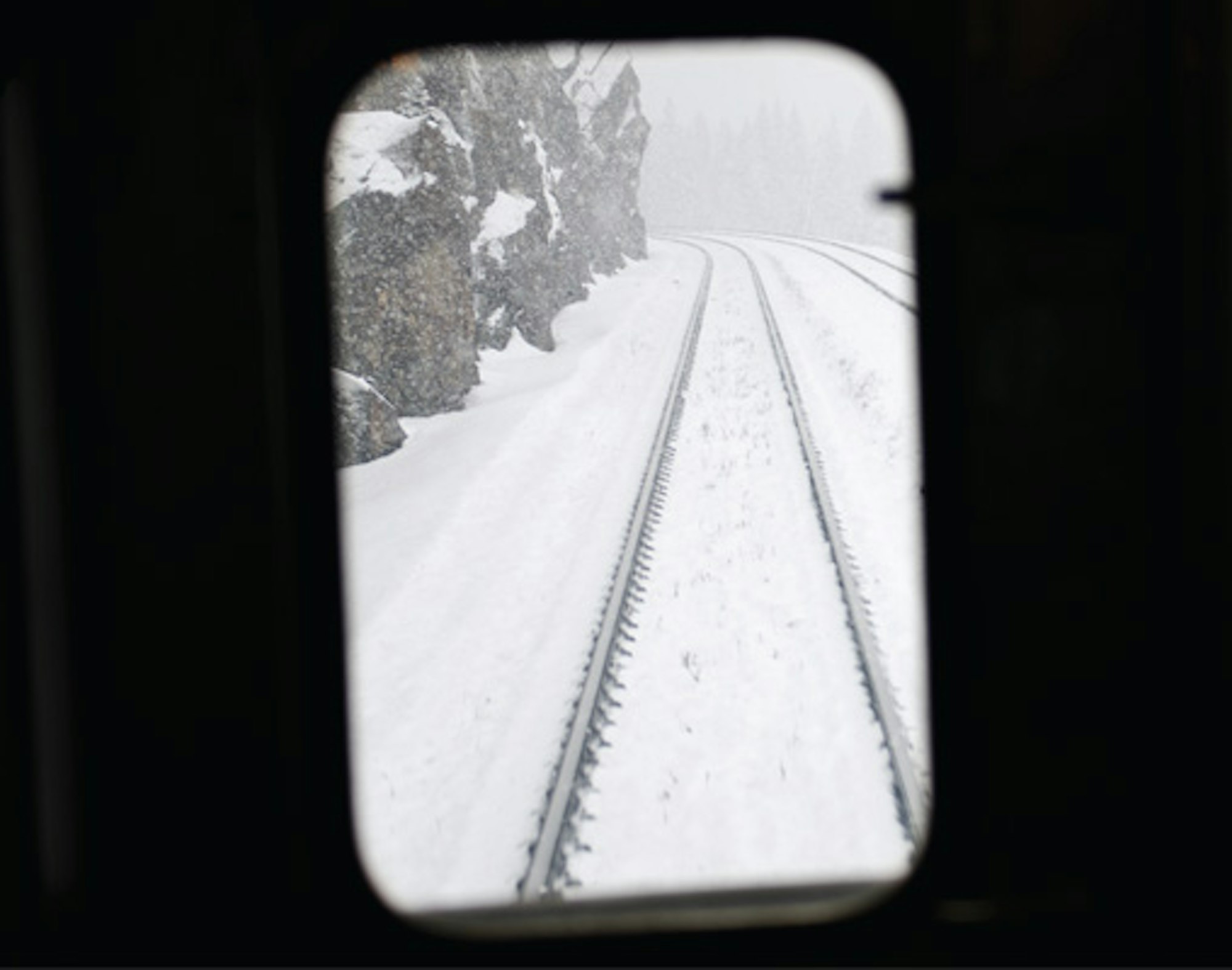by Brigid Mander
“If no one comes by, just flag down a freight train. Seriously, just flag one down! They’ll stop for you,” Tracey, a conductor on the Via Rail train, shouts to us worriedly as she leans out of the car we’ve just hopped off with all our ski gear. The train slowly picks up speed, heading away from us. “Just use that whistle there!” Tracey calls out, a little more frantically now, gesturing at the avalanche whistle on Leah’s ski pack. “It’ll keep the cougars away.”
The train disappears in the distance, leaving us standing by the now empty, snowy tracks. Our crew, skiers Leah Evans, Molly Baker and me, and photographer Re Wikstrom double over in laughter at the cougar comment, but hysterics quickly turn to silence. We are, after all, alone in a thick forest in remote, interior British Columbia in midwinter.
A week and a half ago, we came to Canada to investigate whether rumors of an ideal ski train were true. A road trip without the road? Without $5 per gallon Canadian gas? Where no one has to stay awake to entertain the driver? Who could say no? Canada’s Via Rail passenger train travels through some of the most mountainous and snowy places in British Columbia, so it made sense. We discovered it would let us off and pick us up, whistle-stop style.
And so here we were, standing beside the tracks by mile marker 39.1, looking over our shoulders for unwelcome signs of wildlife.
The Jasper, Alberta train station was our jumping off point. Built in the 1920s, it’s steeped in history. Posters, maps and ads for western migration hang on the station walls, remnants of an era long gone. People landed in these parts nearly a century ago, optimistic and seeking a new life in the West. For us, it serves as a gateway for travels deeper into the Rockies in a search for untapped powder, using the century-old railroad as our sole means of transportation.
Once on the train, heading to our first whistle-stop in the McGregor Range, huge peaks rise up outside the windows. Hours of pleasantly bumping along the tracks lead us to befriend the conductor, Gilbert, who has worked on the rail for decades. “The last trip I did up here, this trapper got on. He had a bearskin—oh yeah, the bears are already out—and about 15 fishers [a weasel relative],” Gilbert says nonchalantly. We stare, and he continues. “That trapper also pans for gold. He has a buyer in Terrace for the fur and the gold. He just stays one night, and I take him back. He has a dog out there he doesn’t like to leave long.”
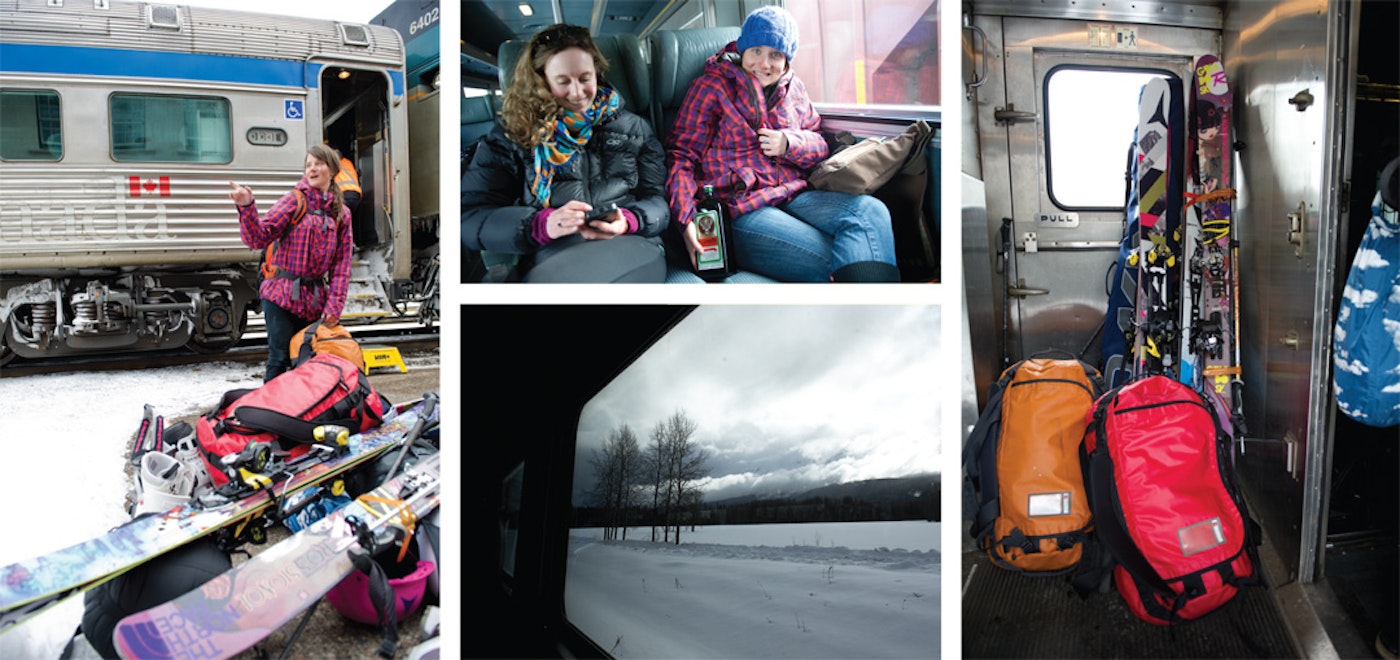
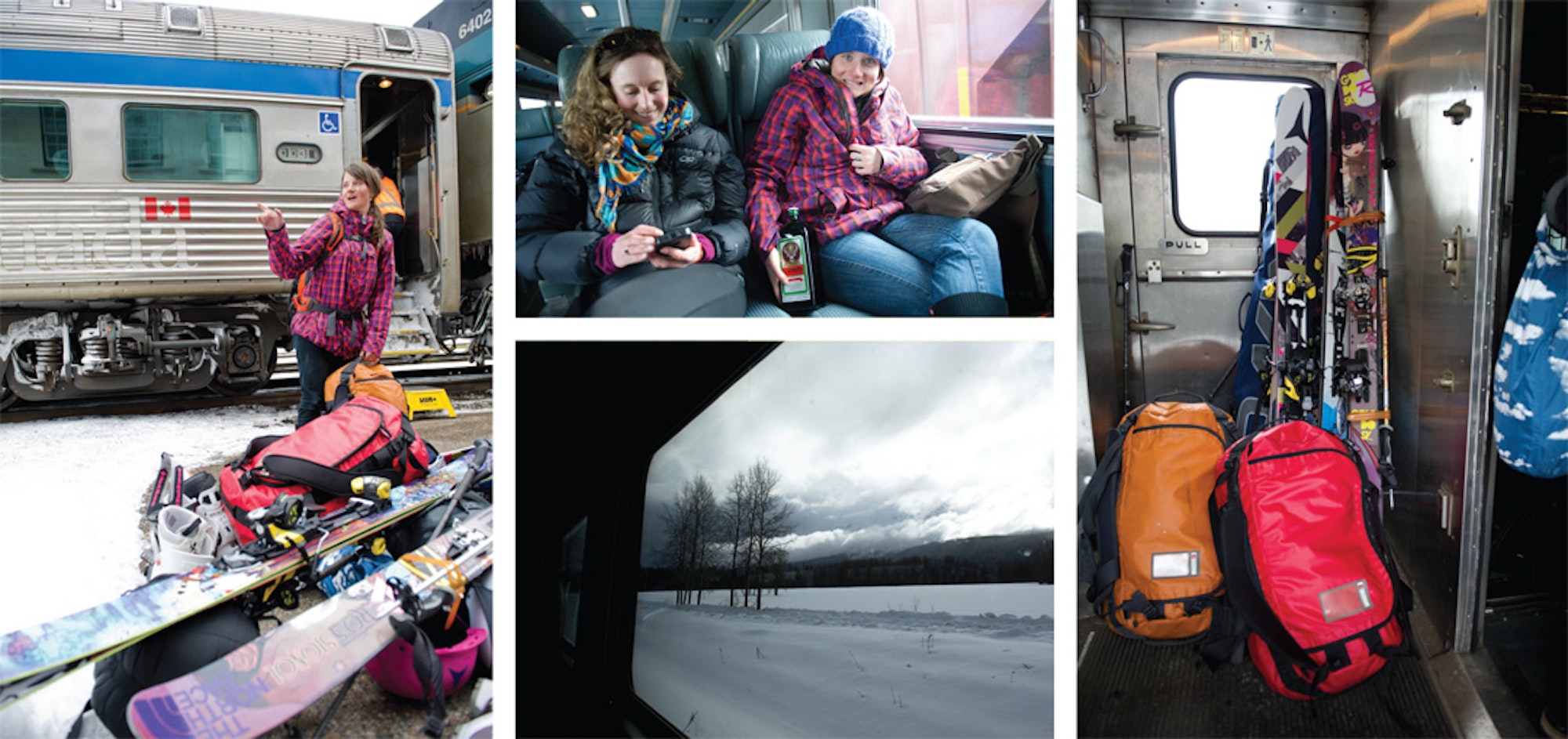
Photos by Re Wikstrom
The mountains outside are socked in from a storm, and Gilbert describes what we can’t see—huge icefalls and Mount Robson, the second highest peak in BC. He continues with tales of strange characters who use the train to access the BC interior, but I interrupt for the 16th time: “We want to get off at mile marker 91.” At mile 91, located about an hour before the station in Prince George, the train stops. The conductor holds the door open, and we hop out on the tracks and smile. This scheme was working.
We’ve arranged to borrow a few snowmobiles from nearby outpost Bear Paw Heli-Skiing. We ride 30km up an abandoned logging road to the Pass Lake trailhead. A few hours of skinning through at least a foot of fresh—where we catch glimpses of stunning alpine terrain through the otherwise socked in clouds—brings us to our destination, a cozy, six-person structure called Pass Lake Cabin. We set up and hope for clear skies, but the low clouds and winds hang around for our two-and-a-half day stay. Relegated to the woods, we find powder in the trees and little features to play on, sufficiently entertaining ourselves.
We can’t be too upset. The tree skiing is ideal: widely spaced old-growth forest and rolling steeps. Besides, this is only stop one, and we have a time constraint. We have to be back at the tracks in time to flag down the next Smithers-bound train, which passes by only every three days.
“I told some friends I was going to Prince George, Smithers, and Terrace, and one of them asked me if I’d started working in a mill,” says Leah as we rock along from Prince George to Smithers. It’s true, skiing isn’t the first thing to come to mind when you mention the destinations along the railroad. The isolated villages are industry towns with forestry and mining historically taking priority. They are not scripted pseudo-Tyrolian or Swiss tourist villages but utilitarian industry centers. Traveling the mostly undeveloped interior expanse of British Columbia by train is daunting and requires more motivation than cruising the Powder Highway, but the reward is an untapped universe of prime backcountry ski terrain. Utilizing the skeletal support system of these far-flung communities, it’s easy to delve deep into wilderness adventures.
A small town of 5,000, Smithers has an uncontrived European influence thanks to an influx of German, Swiss and Dutch immigration in the middle of the 20th century. It isn’t quite clear if its nickname, Little Switzerland, came about because of the immigrants or the towering, ice-encrusted alpine peaks presiding over town. We’ve stopped here to get up into those peaks, via the Hankin Evelyn Recreation Area, a touring-specific ski area.
In Hankin’s parking lot, a local girl in a flatbed, with two dogs standing on the back, is busy plowing new snow, and a nomadic ski bum is living in a tent with a woodstove. Signs explaining the history of the area and warning about avalanches are both nearly buried in snow. A BCA beacon checker provides the gate to the designated, gladed uptracks. We climb through a foot of fresh up to the warming hut, from which we boot up a ridge into the spectacular alpine.
The peaks here are steeper, more jagged looking than the McGregors, and the forest is an impenetrably thick wall of pines; being able to access the alpine via these gladed tracks is worth a lot. Up in the alpine, we take full advantage of the terrain, the clear day and more new snow. Untracked ridges drop down into bowls, with chutes, features, and options galore. Only a beautiful blue sky is witness to the shredding.
The novelty of this little touring-oriented complex, here in the middle of nowhere, is the extremely interesting experiment of one local businessman and the skiers and community that got behind him, which includes the federal government by providing the majority of the funds. Low impact expansion and improvements are still coming, such as another hut, and features to jib on the rolling, super fun runs that come back down to the lot. No matter who was behind it, though, the skiing measures up to our standards, and we all agree: we’d come back without hesitation.
A cloud of pungent, acrid smoke suddenly burns my eyes and lungs. I look up, startled, to see our new friend Bill holding a burning bundle of sage about 6 inches from my face. “It’s a blessing for the day,” he says. A Gitxan medicine man told him that the tradition is a blessing from the forest spirits for protection. I check my transceiver again. Protection by both spirits and technology sounds good to me.
We are gearing up at a trailhead, getting ready to climb up what Bill, an eccentric, punk-music loving, perma-culture farmer calls Gnarnia. Bill is a friend of a friend and a voracious backcountry skier, living off his trackside farm midway between Smithers and Terrace, where Tracey the conductor reluctantly dropped us with warnings of cougars. Not only is Bill letting us crash at the farm, he is showing us his stashes.
The spirits are good to us—the sky is clear, the air cold and the snow deep. Bill, on the other hand, sets a brutally steep skintrack in his private ski area. Otherworldy light filters in from the high peaks, and as we climb, the utter remoteness of this spot sinks in. You could spend a lot of time out here and never see another person, a sign of civilization, or a track that isn’t your own. Getting injured isn’t an option. Bill’s descriptions prove accurate. We ski pillow lines, chutes and deep powder.
We’re ready to move on, but we aren’t going to make it to the tracks in time for the train into Terrace. Near the infamous BC Highway 16, with its posters and pleas for people not to hitch (dozens of hitchhikers have disappeared on this stretch of road), there will be no thumbing it. Luckily, Bill wants to ski a line he’s been scoping near Terrace, so we are soon careening to town in his 4Runner. It’s faster than any of us have gone in nearly two weeks. Leah and Molly close their eyes. Re looks borderline ill.
In Terrace, Bill leaves us the keys to the 4Runner, and disappears with a silent, smiling partner to ski their secret line. We stick to our original plan: head to tiny, community-owned and -operated Shames Mountain. Tiny, yes, but what makes it special is that the access road and ski area lead to some of the most mind-blowing, easily accessed backcountry terrain you will lay eyes on, even in BC.
A deep and relatively stable snowpack coats these mountains each season, and on the spectacularly clear days we are there, we see a blend of serious big-mountain terrain, mini-golf features and huge, marshmallowy mounds. On the skin track, friendly locals direct us to the best powder stashes and backcountry routes. By the end of our first hour, we have invites to two parties. When the sidecountry is so vast and the lines so innumerable, maybe it’s pointless to feel possessive of your home turf.
The powder in Shames is the best of the entire trip. Whether it’s the quality, or the terrain and surroundings, it doesn’t matter. Skiing as much as we can fit into our stay, we find ourselves far from being satisfied, and obsessed with delving deeper into Shames’ sea of peaks.
We eventually reconnect with Bill, whose goal, a first descent of one of the gnarlier peaks near Shames, was successful. “It was a bit of an epic, but we got it,” says Bill. “And we named it ‘No Snakes’ since it’s St. Patrick’s Day.” He reports that the snow on the descent was incredible. Molly wonders, again, how she can stay for the season.
As much as we all want to stay, we walk the two blocks to meet our scheduled train to Jasper. We’re late, and the train almost leaves without us. It’s probably an attempt by our collective subconscious to stay until the next train rolls through three days later. The sun beats down as we reluctantly haul our gear onboard. It seems like we’ve skied a season of powder from the train. The silver cars have provided a glimpse into the past, a place to rest and a blank slate to choose our own adventures. After all, these powder-filled mountains are still a new frontier. We might be going back to civilization for now, but our little train, and all that we left unexplored, will call us back.

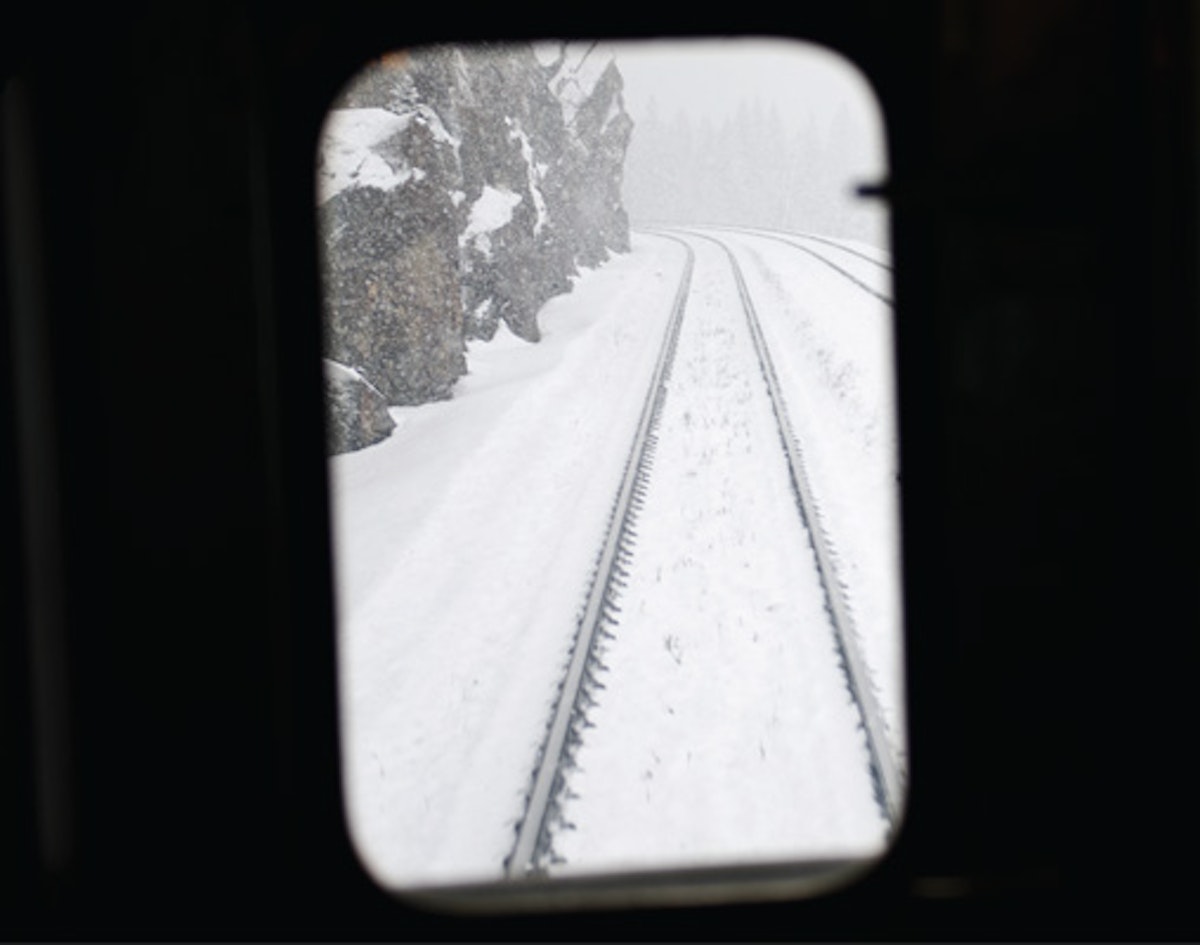
![[GIVEAWAY] Win a Head-to-Toe Ski Setup from IFSA](https://www.datocms-assets.com/163516/1765920344-ifsa.jpg?w=200&h=200&fit=crop)
![[GIVEAWAY] Win a Legendary Ski Trip with Icelantic's Road to the Rocks](https://www.datocms-assets.com/163516/1765233064-r2r26_freeskier_leaderboard1.jpg?w=200&h=200&fit=crop)

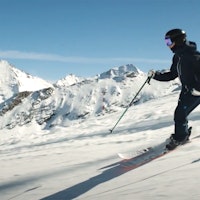
![[GIVEAWAY] Win a Legendary Ski Trip with Icelantic's Road to the Rocks](https://www.datocms-assets.com/163516/1765233064-r2r26_freeskier_leaderboard1.jpg?auto=format&w=400&h=300&fit=crop&crop=faces,entropy)




![[GIVEAWAY] Win a Head-to-Toe Ski Setup from IFSA](https://www.datocms-assets.com/163516/1765920344-ifsa.jpg?auto=format&w=400&h=300&fit=crop&crop=faces,entropy)


